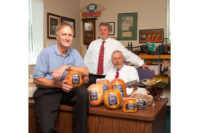

There is no doubt that Chicago still is very much a meat-processing town, as dozens of companies make their home in the Windy City. Those processors carry on a tradition that dates back to the famed Chicago Union Stock Yards, where thousands of workers helped to make the city the center for meat processing in America.
Unfortunately, there are relatively few companies left in Chicago that can date back to the Stock Yards era, but Makowski’s Real Sausage continues to succeed by blending time-tested tastes with contemporary thinking. The Makowski family has run the business since the late 1920s, and while the company’s name may have gone through some alterations, much of its product catalog has remained unchanged.

“We’ve kept the same product line, the same quality since we’ve been in business,” says Nicole Makowski, who has been president of the company since 2002, when she purchased the business from her father and uncle. She and her sister Danielle represent the fourth generation of the family in the business.
The company no longer produces some of the more traditional forms of sausage that were popular in the 1930s and ‘40s, such as blood sausage, but it still makes mainstays like hot dogs, Polish sausages and bratwursts, both for the foodservice and retail industries. Under Nicole Makowski’s leadership, the company has become certified to produce organic sausages, and it has greatly expanded its co-packing business.
“My parents were very supportive about the changes I wanted to make,” she recalls. “[My] great-grandfather would have never imagined we’d be making organic chicken sausages, but [my parents] let us run how we felt best for the business, which made it very comfortable.”

A storied history
Makowski’s Real Sausage originated as Victory Sausage Co. in Lublin, Wis., where Makowski’s great-grandfather ran a butcher shop. He came to Chicago in 1929 because of the meat industry boom and bought a facility on 35th and Ashland. Six years later, he bought the bankrupt Real Sausage Co. and moved to that company’s location, where the company operates to this day. Along the way, the name of the company has changed from Real Packing Co. back to Real Sausage before Makowski added her family’s surname when she took over as a tribute to her family’s work.
Makowski spent her summers in high school working at the plant, and she and her sister had been prepped for being a part of the family business through talks with her great-grandfather. So when she took on the role of president in 2002, she put several initiatives into place. One of those initiatives was to gain organic certification.

“At that time, there were probably 10 establishments in the Chicagoland area that were organic,” she recalls. “We were young and decided to take a little bit of a risk in what was going on.”
The risk paid off, as organic sales performed very well until the economy faltered around 2006 and 2007. The company moved to conventional chicken sausages at that point, but Makowski said that organic sausages are starting to make a comeback.
She has also worked to considerably expand the company’s customer base. In 2002, it was doing co- packing for the retail market. Since then, Makowski’s Real Sausage has entered back into the market as a brand name.
“We had a small grocery store chain that had approached us about some specific items,” she says. “We went ahead and ran some R&D for them, did some samplings with the customers and had some success.”
The problem, she adds, was not only competing against companies with more marketing dollars but also competing against products made more cheaply.

“There are a lot of companies that aren’t making products to the standards that they were 20 years ago,” Makowski explains. “There are a lot of fillers [in use], which we don’t believe in doing. We make the products the same way that we did in the beginning.”
Makowski’s Real Sausage invested in retail-friendly packaging and processing machines and began promoting “Chicago-style” sausages that could not be easily found in stores. The brand gained a foothold among older generations that remembered the brand name from the 1950s and ‘60s, as well as younger generations who appreciated the labeling and product line.
Along the way, the company has kept up its co-packing business, and its relatively small size comes with certain advantages.
“We’re willing to take the extra step and modify products specifically for our customers,” she says, while maintaining the company’s quality. “We can do that with smaller runs and batching, because we are a smaller facility [approximately 25,000 square feet].” Other companies, she notes, ask for 2,000- or 3,000-pound batches for co-packing, while Makowski’s Real Sausage will produce a batch of 200 pounds if requested.
The two sisters serve as the company’s R&D department and have developed about 150 varieties of sausages for customers, so they are well-versed in product development. Makowski says that the company typically develops a test batch for a customer and sends it out for comments or changes. Within two or three trial runs, the sausage is ready for production.
Fortunately, many chefs in the Chicagoland area are seeing the value of sausage and are willing to experiment with different taste infusions or flavors. Makowski says that the company has produced many fruit- and cheese-infused sausages for foodservice customers.
“Sausage is always going to be a low-cost item for a restaurant,” she notes. “It’s never going to be as pricey as a steak or a piece of fish, and there are a variety of ways that you can dress it up to make it more appealing to your customers.”
The production is still done out of the turn-of-the-century, three-story plant, which can cause hassles for the company’s 17 employees. Raw meats are held in the basement. Shipping and packing are done on the first floor, processing on the second floor, and the third floor is used for dry storage. There are freight elevators and dumbwaiters that bring products from one part of the production process to the next.
Makowski notes the struggles of maintaining a century-plus-old building that’s been home to a rough manufacturing environment. Eventually, the plan is to move to a one-story facility, where the process can be made more orderly and efficient. There are many warehouses in the area that are now available, but getting them updated to USDA code would be a large undertaking. Until then, she notes, “we keep a very clean facility that’s to code, and we invite our customers for a walkthrough any time.”
While diversifying the business to help the company navigate the uncertain economy, Makowski is also planning ahead for the next generation, should her children decide to enter the business. The company is geared for slow, steady growth, which seems to work the best.
“Rapid growth is too volatile and too much of a risk for us,” she says. “The slow, steady sales growth over the next five or 10 years can equate to something that’s very successful over the next 30 years.”

Service in the CMMA
Makowski’s involvement in the meat-processing business extends beyond her family’s business. She has been active in the Chicago Midwest Meat Association, and last year she became both its youngest president and its first female president.
“It’s a very big honor that these gentlemen have their faith in me, that I can do the correct job in handling and running this association,” she says.
The association has been around since the 1950s and includes 78 members, as well as 20 people on the board of directors. Makowski says that the initial purpose of the association was to foster camaraderie in the industry, and it offers several events a year. The CMMA also has been actively expanding the association and adding educational opportunities to its members, and it has partnered with other associations such as the American Meat Institute, the North American Meat Processors Association and the National Meat Association.
“It’s more about a group of associations who work together as one, rather than individual associations that alienate themselves,” she explains. Banking and regulatory issues have been chief among the concerns of CMMA members, and the partnerships have helped give the CMMA a bigger voice in the industry.
Makowski notes that many of the companies in the CMMA are generational, family-run businesses like hers, and they can appreciate the value in being a part of something larger than themselves.
“We’re not as large as other associations, so we can definitely offer a personal touch,” she says. “It’s also very good to associate with other companies in your business. You’re going to have those connections that might actually benefit your business.” IP







